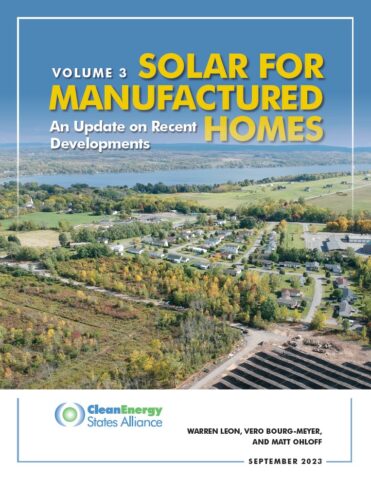Solar for Manufactured Homes: An Assessment of the Opportunities and Challenges in 14 States
Warren Leon, Kat Burnham, Nate Hausman, Laura Schieb, Vero Bourg-Meyer, and Matt Ohloff | Clean Energy States Alliance
Volumes 1 and 2 of this report, as well as the Appendix, were published in April 2021. Volume 3 was published in September 2023 to reflect new federal funding opportunities.
Manufactured homes, formerly referred to as mobile homes, comprise over six percent of America’s housing stock and represent an even larger share of housing for low- and moderate-income (LMI) households. This market should receive targeted attention if solar is to be developed equitably and if all segments of society are to realize economic benefits from solar.
Volume 1 describes the nature of the manufactured housing stock and shows how those homes are distributed across the country. It explains the general obstacles to LMI solar, as well as additional challenges related specifically to manufactured housing. It identifies the types of solar technologies that can work with manufactured housing and includes nine case studies that highlight ways in which solar can be deployed to benefit manufactured housing residents. The report is informed by the results of surveys of solar installation companies and manufactured home residents.
Volume 2 examines the situation in 14 states in different parts of the country, each with different solar markets and policies. It identifies the most promising ways to bring the benefits of solar power to manufactured housing residents in each of the following states: Arizona, California, Florida, Georgia, Kentucky, Maine, Michigan, Missouri, New Mexico, North Carolina, Ohio, South Carolina, Texas, and Virginia.
Volume 3, published in September 2023, provides recommendations for states to leverage federal funding to design solar programs to benefit manufactured homes residents, including the U.S. Environmental Protection Agency’s Greenhouse Gas Reduction Fund Solar for All program and other funding opportunities stemming from the passage of the Inflation Reduction Act (IRA). This publication reflects on lessons learned over the past two years through CESA’s Scaling Up Solar for Under-Resourced Communities project, which includes facilitating the Solar for Manufactured Homes Learning Network and Working Group. The publication also focuses on community solar as a promising model for serving residents of manufactured homes.
The Appendix includes a table which summarizes opportunities for solar for manufactured homes in each of the 14 states studied. The table identifies the market segments, programs, and financing strategies that are most likely to lead to successful solar installations and pilot programs. The table also indicates if certain utilities or categories of utilities deserve special attention.
This material is based upon work supported by the U.S. Department of Energy, Office of Energy Efficiency and Renewable Energy (EERE), specifically the Solar Energy Technologies Office.
Associated Project(s):
Resource Details:
Date: September 26, 2023
Type: Report
Topic(s): Community Solar, Distributed Generation, Finance, Low- and Moderate-Income Clean Energy, Solar Consumer Protection, Solar PV

